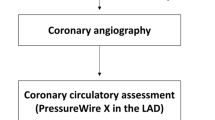Abstract
Background
Endothelium-dependent regulation of coronary tone affects both conduit and resistance coronary arteries. However, little is known about the usefulness of myocardial perfusion imaging in evaluating coronary endothelial function. We evaluated the relation between invasive angiographic measurements of coronary vasomotion in response to intracoronary acetylcholine and the presence of regional perfusion abnormalities assessed by technetium 99m sestamibi imaging.
Methods and Results
We studied 11 patients (9 men and 2 women) with suspected coronary artery disease (48±8 years, mean±standard deviation). We used quantitative coronary angiography to delineate the vasomotor response to increasing doses of acetylcholine given intracoronary. Regional myocardial perfusion was assessed by planar Tc-99m sestamibi imaging during and after the administration of acetylcholine. In the 11 patients, 23 coronary artery territories were analyzed: 13 were angiographically normal, and 10 showed varying degrees of luminal narrowing. Four (31%) of 13 angiographically normal coronary arteries had a positive vasomotor response to acetylcholine (≥20% reduction in luminal diameter) that was associated with a regional perfusion defect. Acetylcholine induced a positive vasomotor response, which was also associated with a regional perfusion defect in 1 of 3 coronary arteries with stenoses of intermediate severity (50% to 69%). Likewise, acetylcholine induced a positive vasomotor response in 6 of 7 coronary arteries with significant luminal narrowing (≥70%), 5 of which showed a corresponding regional perfusion defect.
Conclusions
In patients with coronary artery disease, noninvasive measurements of regional myocardial perfusion by Tc-99m sestamibi correlate well with invasive measurements of coronary endothelial function. These findings may have implications for monitoring the effects of interventions designed to improve endothelial function and microvascular function in patients with coronary artery disease.
Similar content being viewed by others
References
Bassenge E, Heusch G. Endothelial and neurohormonal control of coronary blood flow in health and disease. Rev Physiol Biochem and Pharmacol 1990;116:77–165.
Ludmer PL, Selwyn AP, Shook TL, Wayne RR, Mudge GH, Alexander RW, et al. Paradoxical vasoconstriction induced by acetylcholine in atherosclerotic coronary arteries. N Engl J Med 1986;315:1046–51.
Egashira K, Inou T, Hirooka Y, Yamada A, Maruoka Y, Kai H, et al. Impaired coronary blood flow response to acetylcholine in patients with coronary risk factors and proximal atherosclerotic lesions. J Clin Invest 1993;91:29–37.
Chilian WM, Eastham CL, Marcus ML. Microvascular distribution of coronary vascular resistance in beating left ventricle. Am J Physiol 1986;251:H779–88.
Selzer RH, Hagerty C, Azen SP, Siebes M, Lee P, Shircore A, et al. Precision and reproducibility of quantitative coronary angiography and applications to controlled clinical trials. J Clin Invest 1989;83:520–6.
Hasdai D, Gibbons RJ, Holmes DR Jr, Higano ST, Lerman A. Coronary endothelial dysfunction in humans is associated with myocardial perfusion defects. Circulation 1997;96:3390–5.
DiCarli M, Czernin J, Hoh CK, Gerbaudo VH, Brunken RC, Huang SC, et al. Relation among stenosis severity, myocardial blood flow, and flow reserve in patients with coronary artery disease. Circulation 1995;91:1944–51.
Uren NG, Melin JA, De Bruyne B, Wijns W, Baudhuin T, Camici PG. Relation between myocardial blood flow and the severity of coronary-artery stenosis. N Engl J Med 1994;330:1782–8.
Zeiher AM, Drexler H, Wollschlager H, Just H. Endothelial dysfunction of the coronary microvasculature is associated with coronary blood flow regulation in patients with early atherosclerosis. Circulation 1991;84:1984–92.
Zeiher AM, Krause T, Schachinger V, Minners J, Moser E. Impaired endothelium-dependent vasodilation of coronary resistance vessels is associated with exercise-induced myocardial ischemia. Circulation 1995;91:2345–52.
Vita JA, Treasure CB, Nabel EG, McLenachan JM, Fish RD, Yeung AC, et al. Coronary vasomotor response to acetylcholine relates to risk factors for coronary artery disease. Circulation 1990;81:491–7.
Campisi R, Czernin J, Schoder H, Sayre JW, Schelbert HR. l-Arginine normalizes coronary vasomotion in long-term smokers. Circulation 1999;99:491–7.
Panza JA, Quyyumi AA, Brush JE Jr, Epstein SE. Abnormal endothelium-dependent vascular relaxation in patients with essential hypertension. N Engl J Med 1990;323:22–7.
Nitenberg A, Valensi P, Sachs R, Dali M, Aptecar E, Attali JR. Impairment of coronary vascular reserve and ACh-induced coronary vasodilation in diabetic patients with angiographically normal coronary arteries and normal left ventricular systolic function. Diabetes 1993;42:1017–25.
Dayanikli F, Grambow D, Muzik O, Mosca L, Rubenfire M, Schwaiger M. Early detection of abnormal coronary flow reserve in asymptomatic men at high risk for coronary artery disease using positron emission tomography. Circulation 1994;90:808–17.
Ross R. The pathogenesis of atherosclerosis—an update. N Engl J Med 1986;314:488–500.
Furchgott RF, Zawadzki JV. The obligatory role of endothelial cells in the relaxation of arterial smooth muscle by acetylcholine. Nature 1980;288:373–6.
Zeiher AM, Drexler H, Wollschlaeger H, Saurbier B, Just H. Coronary vasomotion in response to sympathetic stimulation in humans: importance of the functional integrity of the endothelium. J Am Coll Cardiol 1989;14:1181–90.
Author information
Authors and Affiliations
Corresponding author
Additional information
Dr DiCarli is the recipient of a Scientist Development Grant from the American Heart Association, Dallas, Tex.
Rights and permissions
About this article
Cite this article
Masoli, O., Baliño, N.P., Sabaté, D. et al. Effect of endothelial dysfunction on regional perfusion in myocardial territories supplied by normal and diseased vessels in patients with coronary artery disease. J Nucl Cardiol 7, 199–204 (2000). https://doi.org/10.1016/S1071-3581(00)70007-9
Received:
Accepted:
Issue Date:
DOI: https://doi.org/10.1016/S1071-3581(00)70007-9




